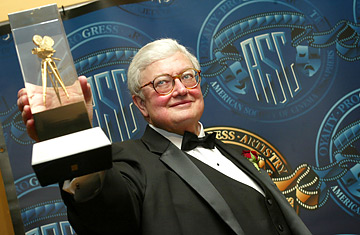
Film Critic Roger Ebert
(4 of 5)
A FRIEND INDEED
Roger is a man with a tough hide. (And, according to my mother, a smooth one. She once stroked his face and said, "You have beautiful skin.") He's one of the few critics who can take it more than he can dish it out, as I know firsthand. In 1990, for Film Comment, I wrote a piece called "All Thumbs," about what I saw as the devolution of film criticism, and cited the Siskel-Ebert TV show (not their other writing) as an example of movie reviewing being reduced to opinion. In the next issue, Roger responded to these charges with a dispassionate grace that acknowledged some of my points, took issue with others, but never stooped to stridency. (The exchange was reprinted in last year's Awake in the Dark: The Best of Roger Ebert: Forty Years of Reviews, Essays and Interviews, which is the best introduction I know to his work.) His equanimity showed class.
Since 1994 Roger has devoted two Sunday columns a month to reviews of Great Movies. In 2001, when he decided to collect 100 of these critiques into a book, he asked Mary, who had been running the Museum of Modern Art's Film Still Archive since 1968, to choose the photos for each film and write an essay about the glamour and preservation of movie stills. In early 2002, just as the book was to be published, Mary was abruptly laid off by the Museum in a move many saw as punishment for her very active role in a strike of MoMA staff members 18 months earlier. (For a fuller discussion of this story, see here.) Mary's layoff, and the closing of the Still Archive, became a cause celebre, and many film professionals rose to her defense; but the first one was Roger, who wrote an outraged letter to the New York Times the day after she was laid off. It was both a valued act of friendship and the declaration of a union man that the workers of the world had to stick together.
A few weeks later, on that year's Floating Film Festival, he brought Mary into a Q&A on the book, again championing her cause (and on karaoke night sang "The Union Maid" in her honor). He volunteered to testify for Mary in the National Labor Relations Board trial that followed; and when he was ready to issue a second volume of Great Movies, he asked Mary again to do the photo selection, though she was no longer in charge of a picture archive. It happens that, five years later, the Museum has reopened in much larger quarters, but its 4 million stills remain in cold storage in rural Pennsylvania, and Mary stills waits for both the Archive and her job to reopen. But Roger would probably agree with a quote from one of his favorite movies: that lost causes are the only ones worth fighting for.
